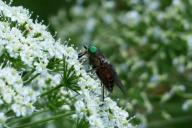The quality and the condition of your equipment makes a huge difference in terms of gardening - so keep your rake nice!
Metal rakes can be quite useful for gardeners, but you should take good care of them, so they won't become rusty.
Here are a few reasons why a garden rake can become rusty pretty quickly.
Moisture Matters
The garden is a damp place, and if your rake gets wet and stays that way, rust is more likely to make an appearance.
Make it a habit to store your rake in a dry spot or under cover, especially during rainy days or dewy nights.

Soil's Role in Rust
Believe it or not, the kind of soil you're working with can play a part in rusting. Acidic soils can speed up rust formation.
After gardening, give your rake a good clean to remove any soil residues that might encourage rust.
Fertilizer Fallout
When you use fertilizers, some of the chemicals can stick to your rake. If not cleaned off, they can contribute to rusting.
After fertilizing, take a moment to wipe down your rake to keep it free from these corrosive remnants.
Leftover Plant Bits
Those tiny pieces of plants stuck to your rake might seem harmless, but they can trap moisture and promote rust.
A quick post-gardening clean, ensuring no organic bits are left behind, can make a big difference.
Storage Strategies
Where you store your rake matters. Storing it directly on the ground or in a cramped, humid space can speed up rusting.
Elevate your rake, keep it in a dry area, and let some air circulate around it for better protection.
Material Wear and Tear
Even the toughest rakes can succumb to wear over time.
Continuous use, exposure to the elements, and material fatigue can make your rake more prone to rust.
Regularly check your rake for signs of wear and consider replacing it when needed.









